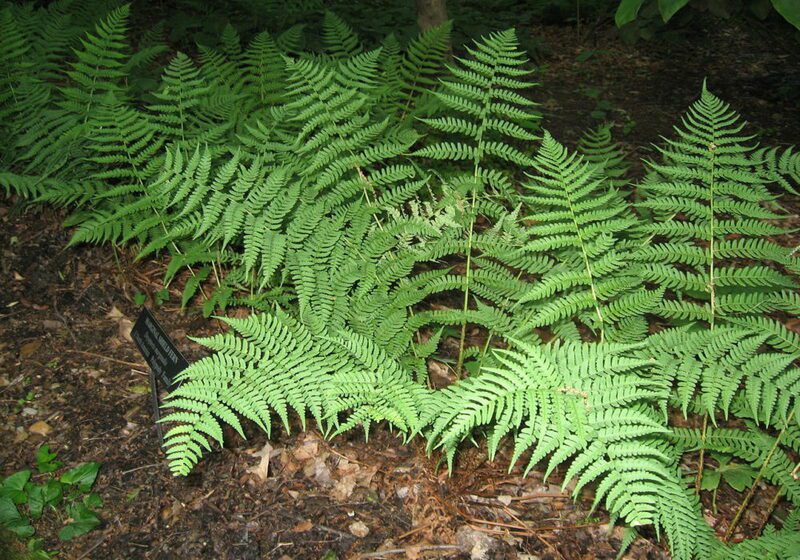Wood Fern
Like all ferns, the wood fern reproduces itself by spores. Large, round spore clusters form directly on the leaves in parallel rows on either side of the center vein.
The spores mature during the warm months between April and November
In the cool, moist overgrowth of the Santa Monica Mountains National Recreation Area forest, protected from the blazing California sun by the leaves and branches of coastal oaks, the wood fern thrives.
With a range that stretches from Washington state through Southern California, the plant prefers moisture and shade but can survive during hot, dry spells.
Ferns, usually tender to drying winds and high temperatures, can grow to 50 feet long in other parts of the world.
The wood fern is generally shorter, hardier, and is drought-resistant.
Leafy fronds that can grow to 2 1/2 feet long arch out from a woody base, their tips sometimes brushing the ground. Dark green and spiny-toothed leaf segments project from the frond’s center stem.
Like all ferns, the wood fern reproduces itself by spores. Large, round spore clusters form directly on the leaves in parallel rows on either side of the center vein. The spores mature during the warm months between April and November.
The plant belongs to the Dryopteris family and is one of three types found in the West. It has no practical use, but a cousin, the male fern, is a potent tapeworm remedy.
Ferns are cool, colorful, lush, and refreshing, especially during a hot Texas summer.
Ferns have been around for a long time. Scientists tell us that ferns appeared on Earth at least 350 million years ago, and there are 10,000 species throughout the world.
They are still considered primitive plants in terms of botanical development, and they do not produce flowers or seeds.
Because of their delicate appearance, ferns add variety and texture. There are varieties that can be grown inside or outdoors.
As houseplants, ferns can bring the feeling of the forest indoors. Outdoors, a large fern brings a feeling of cool lushness to the home garden.
Texas native flora includes a number of ferns. Some are easy to transplant from the woods and use in permanent outdoor plantings. However, few native species make satisfactory houseplants.
The wood fern is difficult to grow in gardens.
Many favorite ferns are available from garden centers.
Among the most popular ferns are:
*BOSTON FERN: Long, arching, light green fronds. The size varies, and they can be used in massive hanging baskets.
*BIRD’S-NEST FERN: Fronds are broad, leathery, and shiny green. As the plant ages, it begins to resemble a bird’s nest. Suitable for home or office.
*STAGHORN FERN: Resembles a stag’s horns. It can produce a massive plant and is easy to grow. Performs well indoors under adequate lighting. However, large plants can be pretty expensive because of their slow growth.
*TABLE FERN: Foliage is medium green, and some types have creamy –white markings in the center of each leaflet. Depending on the variety, fronds can grow up to 3 feet.
*ASPARAGUS FERN: Soft, fluffy appearance. Although this–resembles a fern, the plant is a member of the lily family. It can become quite prominent in hanging baskets. Nearly winter-hardy in the Austin area. Without question, this is the easiest fern to grow.
*MAIDENHAIR FERN: Frequently grows wild among rocks near creeks in –Central Texas. Foliage is lacy with light-to-medium green color. Has small fan-shaped leaves. It proliferates, with some types reaching 12 inches or more in height. Requires frequent misting in the dry air of most homes.
*RABBIT’S FOOT FERN: Excellent for hanging baskets because rhizomes–will grow around the sides of the pot. It does well in the shade and grows up to 18 inches tall. Interesting conversation piece.
*RIVER FERN: Commonly grown in shaded landscapes. A light, airy, easy-to-grow fern that will freeze back each fall and return in the spring. Outstanding for outdoor use. Can grow up to 3 feet tall.
*HOLLY FERN: One of the few winter-hardy ferns. Has become widely –available and popular in shaded areas. Dark glossy green fronds produce a dramatic landscape accent.



























Comments are closed.